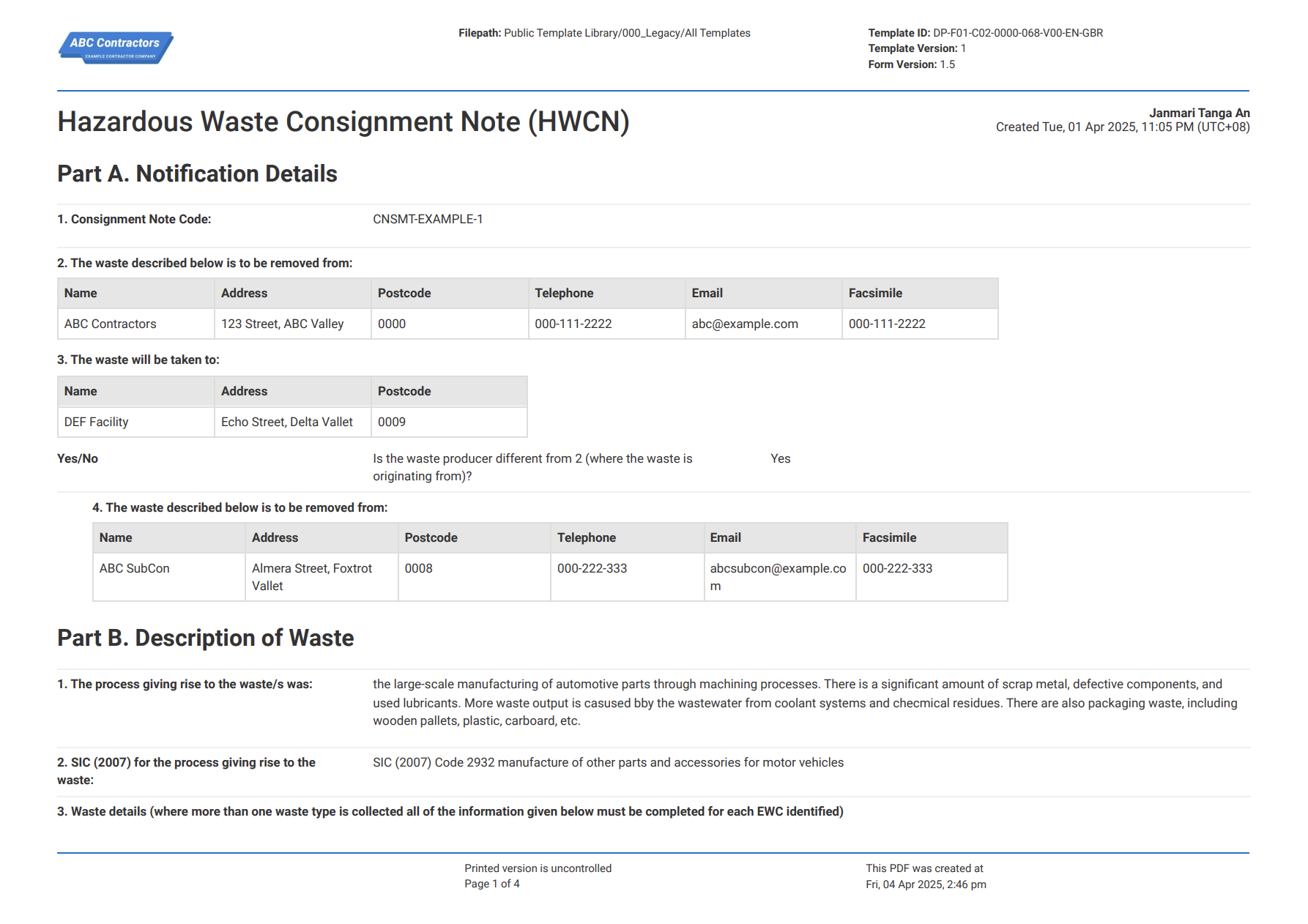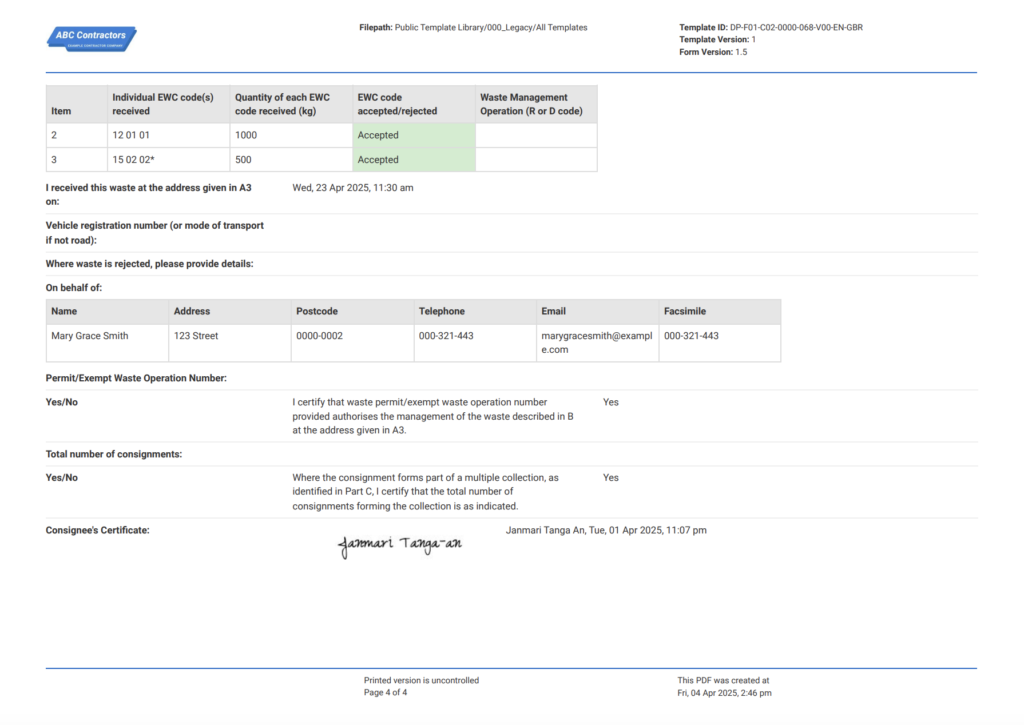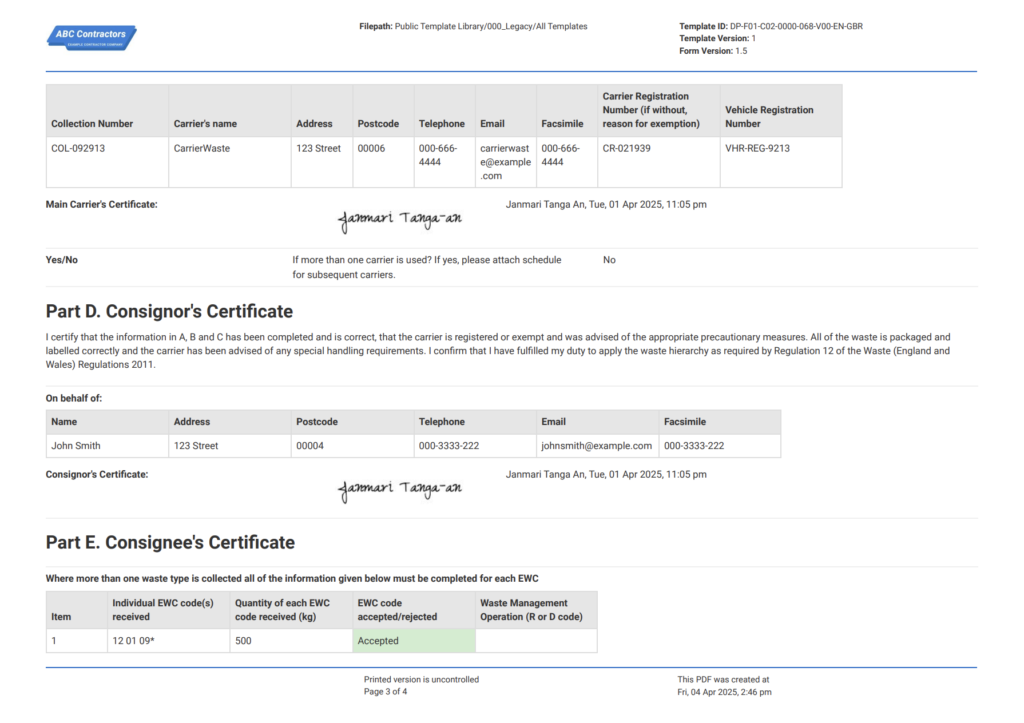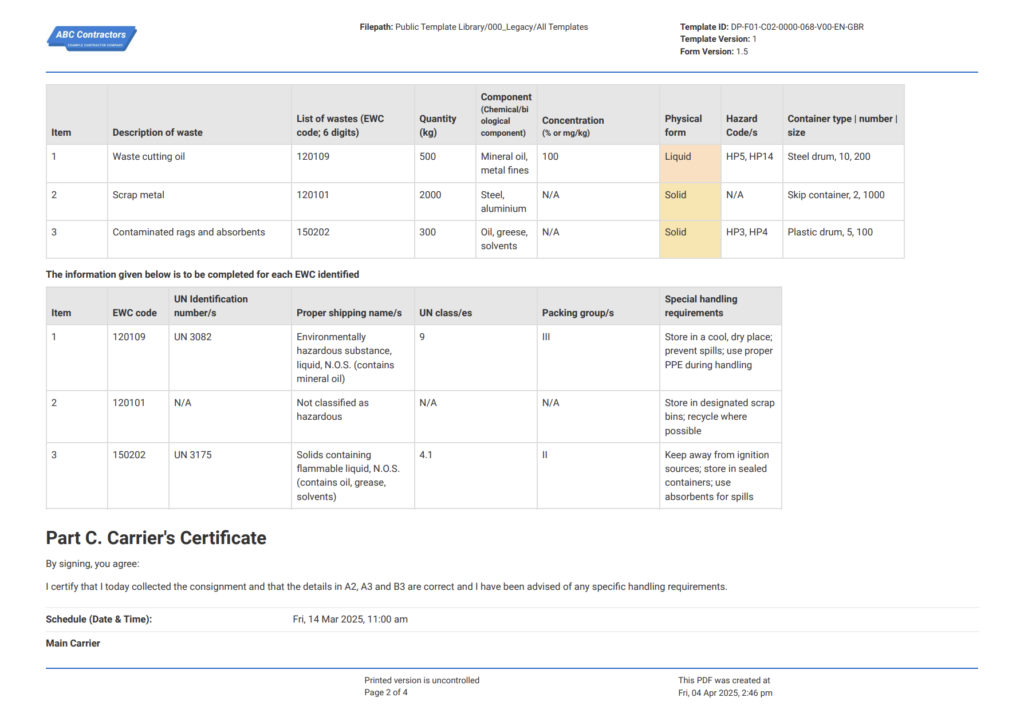Hazardous Waste Consignment Note Template and PDF Example
Start with a free 30-day trial. No credit card required.

~10,000 employees
~10 employees
~200 employees
~25,000 employees
~1,000 employees
~1,500 employees
~30 employees
What is a Hazardous Waste Consignment Note?
To keep the environment safe from the harmful substances and waste in general, they must be stored and disposed of properly. Many companies lack the proper disposal methods for hazardous waste, so need to move this waste to facilities that are better equipped to manage them. The transfer of this waste requires a hazardous waste consignment note to document the transfer process.
The hazardous consignment note serves to prevent actions such as unlawful dumping, incorrect disposal, and waste mishandling by making sure that waste disposal procedures follow the regulatory requirements. For companies that produce waste, this guarantees adherence to the duty of care, which obligates companies to practice due diligence in preventing harm to people and the environment.
Compare this digital Hazardous Waste Consignment Note to manual Word, Excel and PDF forms
Use this Hazardous Waste Consignment Note Template for free.
Hazardous Waste Consignment Note Guidance
Here's some more detailed hazardous waste consignment note guidance, which you can combine with the template to round out your understanding of the whole process.
The guidance below is designed to apply to any hazardous waste consignment note template and/or wofkflow:
Notification Details: In this section of the form, information is provided on the origin of the hazardous waste as well as the destination to which the waste is to be disposed of or handled. The purpose of providing these details is to guarantee traceability and to account for the various parties engaged in the transportation of hazardous waste.
Description of Waste: This part provides meticulous information about the waste to be transported. With particulars here, it will provide the establishment on the proper measures on how to group, contain, and dispose of the hazardous waste. Most of the information here is based on the regulatory standards provided in the region or area. It is critical to input the correct details here, for the wrong details can lead to mishandling and improper disposal.
Carrier’s Certificate: In this portion of the form, the carrier or transporter who will be delivering the hazardous waste to its intended destination will verify and review the data entered in the previous two parts. When satisfied with the information, the carrier can approve and sign the form to officially receive it from the establishment that generated the waste. Furthermore, the information of the carrier is also included in this section in order to ensure that the trash can be traced back to the person who was handling it while it was being carried.
Cosigner’s Certificate: An impartial third party should be engaged in the process of rechecking everything in order to eliminate any potential biases that may exist between the entity that generates the waste and the transporter. In this section, the cosigner also checks the first two portions of the document, verifies whether or not the carrier is a registered body to handle waste transportation, and acts as a mediator to ensure that all parties have agreed to every piece of information that has been provided on the form. After everything has been settled, he will next sign this section of the form to acknowledge that the waste is ready to be transported.
Cosignee’s Certificate: The last portion of this form verifies that the waste has been delivered to the location that was intended for. It serves to verify that the waste has arrived in a secure manner, ascertain if all of the value has been accounted for and is really what has come, and offer specifics on the manner in which the garbage is going to be stored, managed, or disposed of. The cosignee signs the document to signify that the hazardous waste has been received and is already properly handled in the facility.
How Long Should You Keep a Consignment Note?
The retention time is determined by the applicable municipal, regional, or federal legislation since various regions may have different regulations regarding appropriate waste disposal. Here, we will talk about the various regional laws for the length of time that a hazardous waste consignment note must be kept on file.
United States of America
In the United States, the Environmental Protection Agency (EPA) emphasises the retention period based on the Resource Conservation and Recovery Act (RCRA). This act states that companies must retain their hazardous waste consignment note documents for a period of at least 3 years, starting from the date the waste was transported. This Act includes establishments that generate, transport, dispose of, and store waste.
United Kingdom
The Environmental Agency of the United Kingdom formulated the Hazardous Waste Regulations of 2005. The regulations here provided the amount of years needed to keep consignment notes. Very much like in the United States, it states that companies and establishments must retain their hazardous waste consignment notes for a period of 3 years. This was to make sure that in case of any environmental legal disputes, records are available for audit and checking.
Australia
The Australian state requires a much longer retention period compared to the former regions mentioned above. The environmental agency in Australia, which is the Environmental Protection Authority (EPA), states in their industrial waste resource guidelines under the Environmental Protection Act of 2017 that companies and industries should have at least a 5-year retention period of all waste transport certificates and waste tracking documentation, which includes the hazardous waste consignment note.
Japan
In Japan, the Waste Management and Public Cleansing Act (WMPCA) mandated the number of years in retaining the documents for tracking industrial and hazardous waste. In Article 12-3 of the WMPCA, it states that “manifests” (known as the hazardous waste consignment notes in Japan) are a mandatory requirement in the nation. Additionally, Article 14 specifically mentions that the retaining period of these manifests should be at least 5 years, which is the same as Australia.
Hazardous Waste Consignment Note Retention Period
To fully understand why the regions above provided the required years for the hazardous waste consignment to be retained, let us first place ourselves in the shoes of the auditor. One important aspect that an auditor looks at is consistency. As they go through the files, they will check to see whether the company has been really religious in its practice of carefully completing the paperwork that demonstrates its compliance with the regulations.
Having a compilation of records for 3-5 years can really provide auditors with ample information if there have been any inconsistencies with handling the transportation of waste. With this said, the provided retention period hugely reflects on how responsible a company is in keeping up with their duty to care. This means that the requirement for the retention period was decided to fully have a gauge if companies are really dedicated to complying with regulations.
Another reason why the retention period was made to be of this length was because of audit cycles. Most audit cycles happen to be every 3-5 years. When audits happen, auditors often review all the documents that have been compiled from the last audit to the recent one. If there were findings on the previous audit, changes are more apparent with the required retention period. This can help auditors see if there was an improvement or if the problem is still existing. This also gives companies enough time to implement changes in their processes. The time is plenty enough to either correct a finding or further improve their process.
To conclude, the retention period was decided to balance due compliance and provide recognisable changes. It was agreed to make sure that the auditors have enough information to see if the company was truly responsible in complying with regulations and to give companies enough time to establish processes that can further improve their compliance with legal requirements.
Other popular templates you can use and customise for free

Environmental Action Plan
Create and implement actions that improve environmental standing and performance.

Hazardous Waste Management Plan
Manage a project while minimising its environmental impact

Environmental Risk Assessment
Ensure you have taken the right measures to protect the environment and your team.
This Hazardous Waste form was generated with Dashpivot
Making workflow forms has never been this easy. With a digital template, creating forms like this is now simpler, faster, and more user-friendly. Streamline the process around your hazardous waste consignment note using this digital example.
- Access the hazardous waste consignment note from any device, including a mobile phone, tablet, or computer, and make any necessary changes or additions.
- Consignment notes for hazardous trash may be printed, downloaded, or sent as well-formatted PDF documents, including your company's brand.
- Store your documents safely on the internet so they can be quickly and easily located.
- The hazardous waste consignment note records may be seen, edited, and approved online by both internal and external parties.
Sitemate builds best-in-class software tools for built world companies.



